
by Joshua Criss | Jul 14, 2022
The Case for Bats
Biological control is a pillar of integrated pest management. It may seem a bit daunting the principle is simple. All things in nature have predators including insects. Biological control is simply building a conducive environment for the predators of undesired pests. One animal not often thought of in this capacity is bats. Insectivores by nature, these underutilized creatures have a big impact to your open spaces. Their steady diet of moths (Lepidoptera), beetles (Coleoptera) and flies (Diptera, which includes mosquitoes) reduce insect pressure to your gardens and landscaping.
I know what you are thinking. How effective can they possibly be? Pregnant females consume up to two thirds of their body weight through the summer months while rearing pups. Bats are small but keep in mind that these are not solitary animals. In south Texas, a single large colony consumes enough insects to save cotton farmers an estimated $741,000 per year in insecticides. That is just to illustrate the point as you won’t be able to attract huge colony. There is no reason to believe a smaller colony will not provide similar services in your gardens.
Habitat
Now that your interest is piqued, how can you attract bats to your property? Installing a bat house is the easiest way. They are typically a two foot by one foot structure holding single or multiple chambers in which bats roost. It provides shelter from predation and weather while providing a place to rear pups. Though commercially available they may be built at home with minimal cost. Place the bat house in a location with morning sun at least 12 feet off the ground. Ensure there is enough airflow around the house to keep them cool, but that the structure is watertight. Mount houses on poles next to buildings and you’ll have better success attracting residents. With everything in place, it is time to discover who will most likely be your new neighbor.
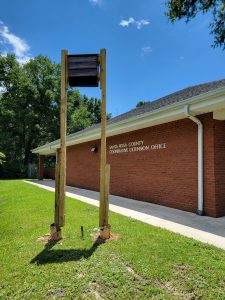
photo: Joshua Criss
The Bats of North Florida
Florida is home to 13 species of bats statewide. Of these, 11 may be found in the Panhandle but only 3 are common enough to be routinely seen. The Brazilian free-tailed bat (Tadarida brasiliensis) is the most common. Medium sized with brown fur, they have a long tail, wrinkled cheeks, and roost in man-made structures.
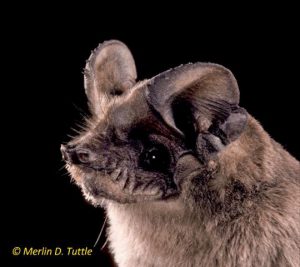
Photo: IFAS
Second most common are Evening bats (Nycticeius humeralis). These dark brown to yellow bats have short ears with a broad hairless muzzle. They are tolerant of other bat species often roosting in tandem with them.
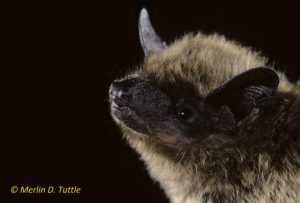
Photo: IFAS
Finally, the panhandle is home to Southeastern Myotis (Myotis austroriparius). Easily the smallest of these bats, they are dull gray to brown with a lighter belly and long hairs between their toes. This species is the bat most likely to eat mosquitoes.
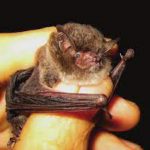
Photo: Jeff Gore, FWC
Finally, the panhandle is home to Southeastern Myotis (Myotis austroriparius). Easily the smallest of these bats, they are dull gray to brown with a lighter belly and long hairs between their toes. This species is the bat most likely to eat mosquitoes.
A Word of Caution
No article on wildlife would be complete without a word of caution. Bats are wild animals and should be treated as such. Never touch a bat on the ground as it most likely is not healthy. Bats do not generally cause issues but have been known to be disease vectors. Call a professional to collect the animal and never bring it into your home.
Bats can be a wonderful tool in controlling pests on your property. Creating habitat can help reduce pesticide need and cost to the homeowner. For more information on bats, see this Ask IFAS document, or contact your local extension agent for additional information on this and any topic regarding your gardens and more.
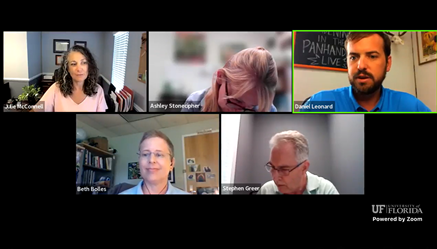
by Matthew Orwat | Jun 14, 2022

The Q&A on Native Pollinators and their Favorite Flowers offered valuable information on many types of flowers that feed our many species of pollinators in Northwest FL. Below are the reference materials related to specific questions that were asked along with notes from the panel discussions.
- Stephen Greer was asked which garden perennials are best for pollinators, he mentioned that Blanketflower, Cardinal Flower, Black Eyed Susan were his top three.
- Julie McConnell was asked, what are some shrubs to benefit birds and pollinators? She stated that insects forage off lawn grasses, but good shrubs are Wax Myrtle, Saw Palmetto, American Beautyberry, Vibernum and Holly Species. Sandy Soil Pollinators: Firebush, Holly, Saw Palmetto, all drought tolerant and good for pollinators.
- Julie McConnell was asked about Fall Pollinator Plants, replying Swamp Sunflower as her favorite.
- What about Winter Pollinator Plants?
- Winter: Mahonia, Fatsia, both good plants for pollinators in shady areas, also Beth added that winter vegetables help pollinators in the winter, such as carrot, wild radish, provide forage for bees, bumblebees and plasterer bees, carpenter bees. Matt Lollar said daikon radish is another good pollinator plant for fall and winter.
- Question from Facebook: Are Loquat trees good for pollinators. How large do they get and when do they bloom? Do they need shade or full sun?
- Are Spicebushes good Pollinator Plants?
- Herbs: Perfect Plants for Pollinators
- What is best for Butterfly Gardening in Florida?
- What are some Favorite Pollinator Plants?
- Better access to native plants: Florida Native Plant Society
- https://www.fnps.org/
- There are Native Plant Nurseries in Bay and Leon County, you can find them on google.
- Some Master Gardner Volunteer programs sell native plants at their sales!
- Stephen: What methods have been successful to approach HOA’s to approve of Native plants in homeowner’s properties?
- Build consensus about native plants before the meeting.
- Covenants or Bylaws. Covenants are less enforceable, Bylaws have enforcement ability.
- Beth: Do we need to supply water for pollinators? YES!
- Is Carolina Jessamine good for bees?
- Growing Sunflowers from seed:
- How Much Bidens alba is enough?
This episode of Gardening in the Panhandle LIVE! is available to watch at https://www.youtube.com/watch?v=BGl4kGYEEs4.
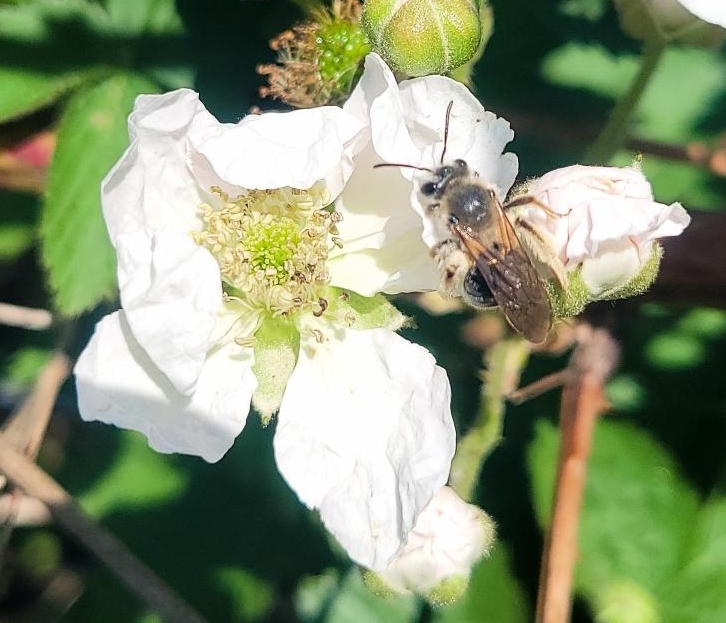
by Donna Arnold | May 5, 2022
As spring approaches, are we thinking about pollinators? How often do we stop to think of the importance of pollinators to food security?
Pollination is often described as the transfer of pollen grains from the anther to the stigma of a flowering plant. These transfers are made possible due to pollinator visits in exchange of pollen and nectar from the plants.
Who are our pollinators?
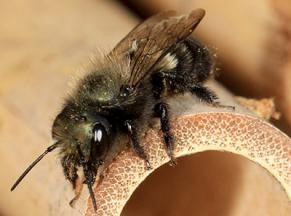
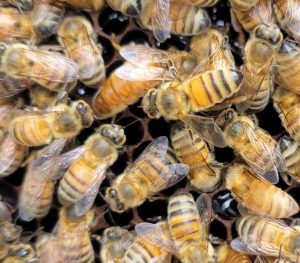

Main Global Pollinators
Social Solitary
Honeybees Alfalfa leafcutter bee
Bumble bees Mason bees
Stingless bees Other leafcutter bees
How can we care for pollinators?
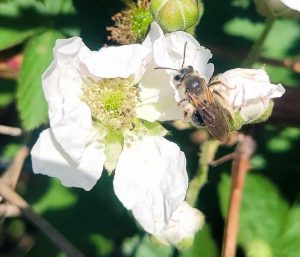
Photo by Donna Arnold
We can care for our pollinators by growing plants that have abundant and accessible pollen and nectar.
Choose plants with flat flowers or short to medium-length flowers tubes (corollas), and limit plants with long flower tubes such as honey suckle.
Avoid plant varieties that do not provide floral rewards (pollen), which is the essential food source for bees. (e.g., some sunflower, and lilies).
Many native wild bees have relatively short proboscises, or tongues, and may not be able to access nectar from flowers with long tubes; however, flowers with long floral tubes can attract other pollinators with long tongues or beaks such as butterflies, moths, and hummingbirds.
Are we creating an ecosystem aesthetically pleasing while attracting pollinators?
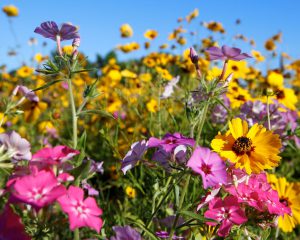
UF/IFAS Photo by Tyler Jones
The planting of native wildflower in Florida can benefit agricultural producers likewise, native pollinators and other beneficials such as parasitoids and predators. Some of the main benefits of growing native wildflower are:
- Increasing wild bee presence in the surroundings.
- Providing nesting and foraging sites for pollinators, butterflies, bees etc.
- Increasing natural enemies of pest insects.
It is important to select mix varieties of native wildflower when restoring habitats for our pollinators. Mix varieties will flower all year round and make available continuous supply of nectar and pollen. If possible, use wildflower seeds that are produced in the state that you want to carry out pollinators’ restoration. It is highly likely that one will experience better growth from locally produced seeds because they will adapt better to regional growing conditions and the climate. For optimum flowering and high production of floral rewards such as pollen and nectar. Place wildflowers in areas free of pesticide and soil disturbance.
Most bee species are solitary, and 70% of these solitary bees’ nest in the ground. A wildflower area of refuge can fulfill the shelter resource needs of these bees since that area will not undergo regular tilling, thus minimizing nest disturbance.
Supporting information for this article can be found in the UF/IFAS EDIS publications (Common Native Wildflowers of North Florida) visit : https://edis.ifas.ufl.edu/pdf/EP/EP061/EP061-15448828.pdf and Attracting Native Bees to Your Florida Landscape IN125500.pdf (ufl.edu.
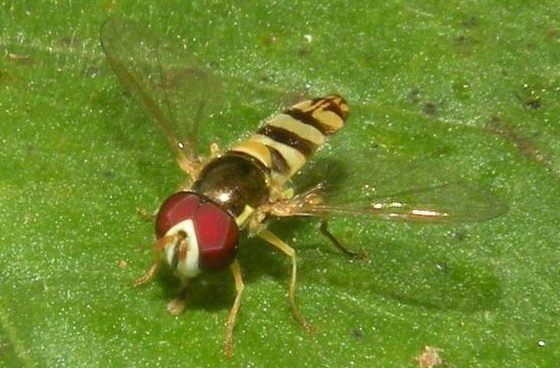
by Molly Jameson | Apr 28, 2022
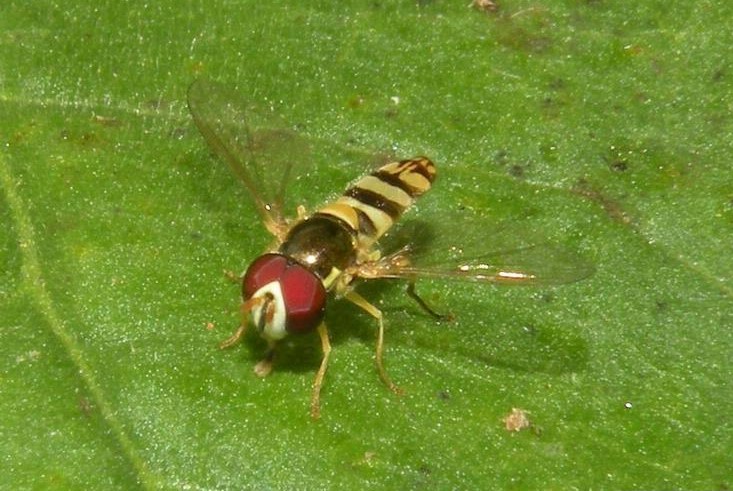
While we think of most flies as pests, garden flies, such as Allograpta obliqua species found in Florida, are excellent pollinators and predators of insects. Photo by Jessica Louque, Smithers Viscient, Bugwood.org.
While our sentiments toward flies usually involve fly swatters, believe it or not, not all flies are nuisance pests! Some types of flies can actually be quite helpful in the garden.
These garden flies are nothing like your typical pesky house fly. While house flies and garden flies are both insects in the order Diptera, they are not in the same insect family, which is the next classification down in Linnaean taxonomy.
The nectar-loving garden flies that specifically visit flowers are in the family Syrphidae and are known as Syrphid flies, hoverflies, or flower flies. Although not as well-known in the pollinating world, there are almost 900 species of flower flies in North America, and they can be very colorful and eye-catching in the garden.
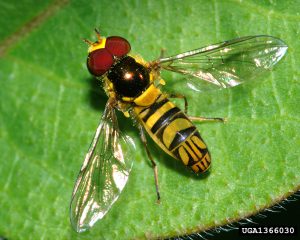
Allograpta obliqua flower fly adults are small and have bright yellow and black crossbands on their abdomens. Photo by Susan Ellis, Bugwood.org.
One of the most common flower flies in Florida is the species Allograpta obliqua. Members of this species, also called hoverflies, are often mistaken as fruit flies, and can therefore be perceived as harmful. But to the contrary, adults cross pollinate many flowers, and hoverfly larvae feed on predators, such as aphids that attack vegetables, fruit trees, cotton, ornamentals, and many wild plants. In fact, when there are numerous hoverfly larvae present, they can reduce aphid infestations by 70 to 100 percent!
Allograpta obliqua adults can be hard to spot, as they are a mere six-to-seven millimeters in length. Although small, they have distinct bright-yellow and black crossbands on their abdomen and become particularly abundant in the spring and summer here in the Florida Panhandle.
So, before you go swatting at any ole fly you see, remember that flower flies are our allies in the garden. Adults will aid in the pollination of our crops and landscape plants, and larvae will help defend our spring and summer veggies from the devastation of harmful insect attacks.
Learn more about Allograpta obliqua hoverfly species at the UF/IFAS Featured Creatures website (https://entnemdept.ufl.edu/creatures/beneficial/hover_fly.htm).
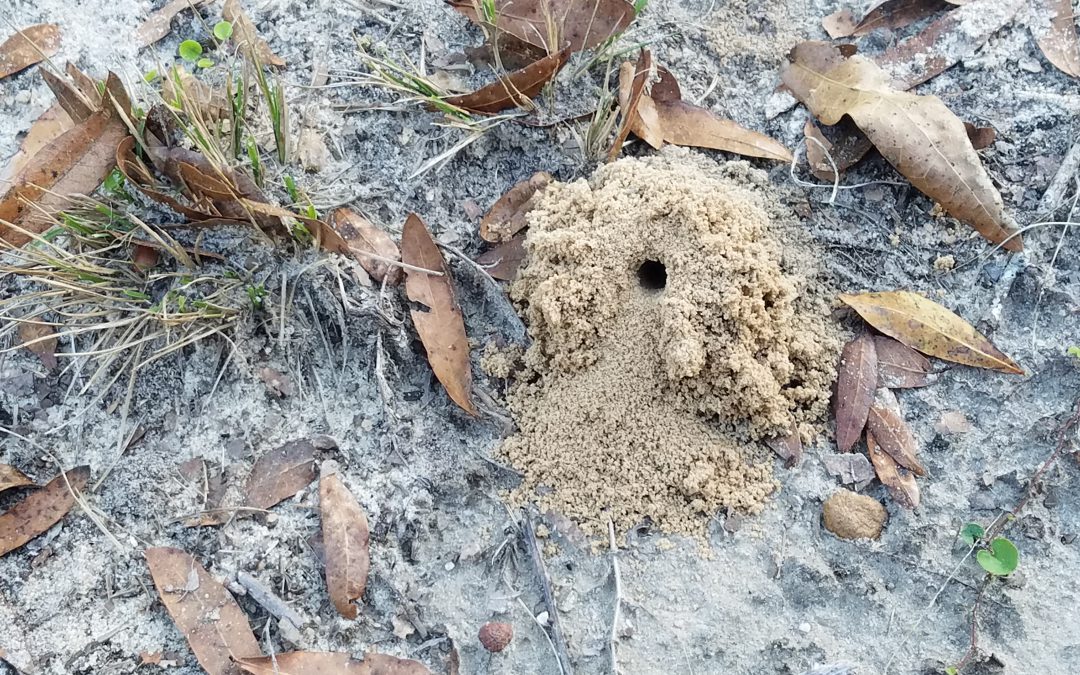
by Evan Anderson | Oct 21, 2021
While most people are familiar with the European honey bee, the domesticated insect that pollinates our crops and provides us with honey, there are plenty of other species of bees and their relatives out there. Most of them are harmless, spending their time quietly pollinating plants, including our crops. Their presence in the landscape, however, may cause some alarm, as it can be difficult for the untrained eye to distinguish between aggressive species and those that are innocuous.
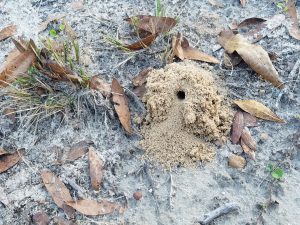
The entrance to a miner bee burrow.
Homeowners may occasionally note small mounds of soil in sandy areas of their lawns. Sometimes sporting a small hole in the center, these are the nesting sites of solitary, ground-nesting bees or hornets. Miner bees or digger bees build underground chambers, usually in well-drained, otherwise bare areas of sandy soil. Multiple bees may choose to dig their nests in the same location, though each bee makes its own tunnel and they do not live communally. Each bee lays her eggs in the nest she has excavated. She gathers pollen to feed the young when they hatch, stocks the larder, and leaves. When the young emerge from the nest, they fly away and do not remain; they will dig their own nests when they are ready to reproduce. While there is no need to control these insects (they serve as fantastic pollinators), the mounds of soil they make may be aesthetically displeasing to some people. Keeping a healthy lawn with no bare patches can deter miner bees from nesting in an area. Irrigation sprinklers can also help to keep the ground moist; these bees prefer dry soil, so it may keep them away. Care must be taken not to over-water a lawn, however!
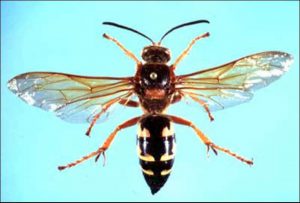
A cicada killer wasp. Photo credit: Division of Plant Industry
Another species of note is the cicada killer hornet. Also known as the giant ground hornet, these insects grow to a size of about an inch and a half in length. Instead of pollen, they capture cicadas to feed their young. Like the miner bee, though, they are not harmful. Females do possess a stinger which they use to hunt their prey. Males may try to warn people or animals away from their burrows by acting aggressive, but they have no stingers. Some may see the large size of the cicada killer and wonder if the so-called “murder hornet” has made its way from Washington state to Florida, but as of this writing it has not. Unless you are a cicada, you have nothing to fear.
One ground-dwelling hornet that does warrant some concern is the yellowjacket. These are communal hornets, living in hives that are often build underground. Yellowjackets are known for their bad attitudes, attacking anyone who disturbs the entrance to their nest. They can be beneficial, being predators of many other insects including plant pests. A colony located too close to human dwellings or areas of activity is most often a nuisance, however. Any attempts to control yellowjacket nests should be done at night when they are less active. Protective clothing is recommended even then. Large or difficult to reach nests may require the attention of a certified pest control company.
For more information on these topics, see our EDIS publications:
Miner Bees: https://edis.ifas.ufl.edu/publication/in912
Cicada Killers: https://edis.ifas.ufl.edu/publication/in573
Yellowjackets: https://edis.ifas.ufl.edu/publication/IN238
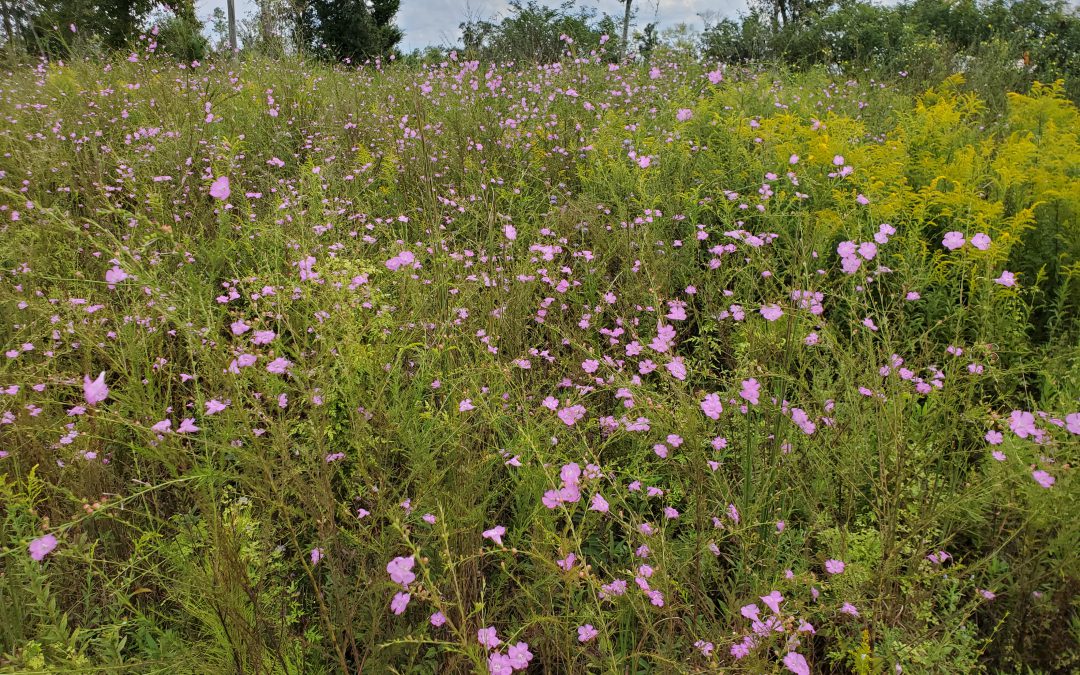
by Daniel J. Leonard | Sep 30, 2021
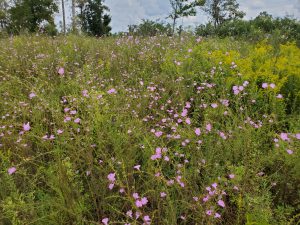
False Foxglove in a Calhoun County natural area. Photo courtesy of Daniel Leonard.
Fall is the absolute best season for wildflower watching in the Panhandle! When mid-September rolls around and the long days of summer finally shorten, giving way to drier air and cooler nights, northwest Florida experiences a wildflower color explosion. From the brilliant yellow of Swamp Sunflower and Goldenrod, to the soothing blue of Mistflower, and the white-on-gold of Spanish Needles, there is no shortage of sights to see from now until frost. But, in my opinion, the star of the fall show is the currently flowering False Foxglove (Agalinus spp.).
Named for the appearance of their brilliant pink flowers, which bear a resemblance to the northern favorite Foxglove (Digitalis spp.), “False Foxglove” is actually the common name of several closely related species of parasitic plants in the genus Agalinus that are difficult to distinguish by all but the keenest of botanists. Regardless of which species you may see, False Foxglove is an unusual and important Florida native plant. Emerging from seed each spring in the Panhandle, plants grow quickly through the summer to a mature height of 3-5’. During this time, False Foxglove is about as inconspicuous a plant as grows. Consisting of a wispy thin woody stem with very small, narrow leaves, plants remain hidden in the flatwoods and sand hill landscapes that they inhabit. However, when those aforementioned shorter September days arrive, False Foxglove explodes into flower sporting sprays of dozens of light purple to pink tubular-shaped flowers that remain until frost ends the season.
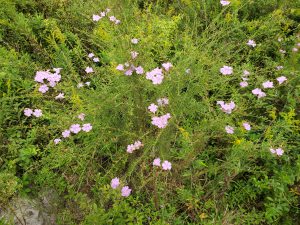
False Foxglove flowering in a Calhoun County natural area. Photo courtesy of Daniel Leonard.
In addition to being unmatched in flower, False Foxglove also plays several important ecological roles in Florida’s natural areas. First, False Foxglove’s relatively large, tubular-shaped flowers are the preferred nectar sources for the larger-sized native solitary and bumble bees present in the Panhandle, though all manner of generalist bees and butterflies will also visit for a quick sip. Second, False Foxglove is the primary host plant for the unique Common Buckeye butterfly. One of the most easily recognizable butterflies due to the large “eye” spots on their wings, Common Buckeye larvae (caterpillars), feed on False Foxglove foliage during the summer before emerging as adults and adding to the fall spectacle. Finally, False Foxglove is an important indicator of a healthy native ecosystem. As a parasitic plant, False Foxglove obtains nutrients and energy by photosynthesis AND by using specialized roots to tap into the roots of nearby suitable hosts (native grasses and other plants). As both False Foxglove and its parasitic host plants prefer to grow in the sunny, fire-exposed pine flatwoods and sand ridges that characterized pre-settlement Florida, you can be fairly confident that if you see a natural area with an abundance of False Foxglove in flower, that spot is in good ecological shape!
The Florida Panhandle is nearly unmatched in its fall wildflower diversity and False Foxglove plays a critical part in the show. From its stunning flowers to its important ecological roles, one would be hard-pressed to find a more unique native wildflower! For more information about False Foxglove and other Florida native wildflowers, contact your local UF/IFAS County Extension office.





















